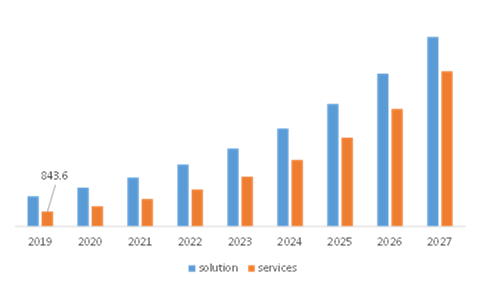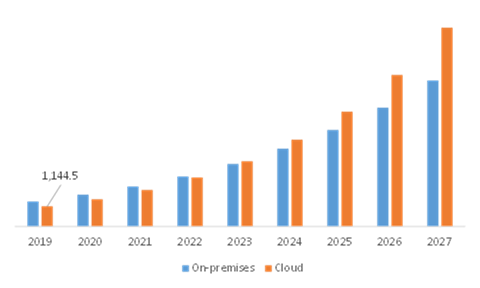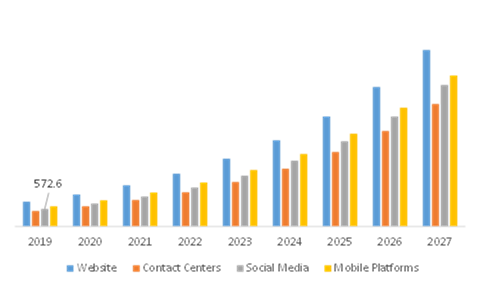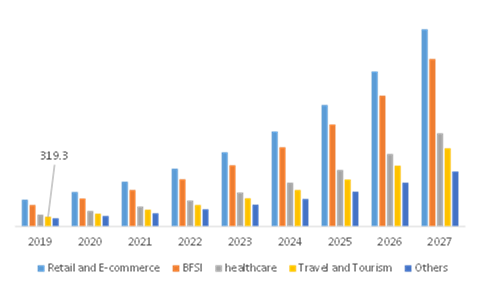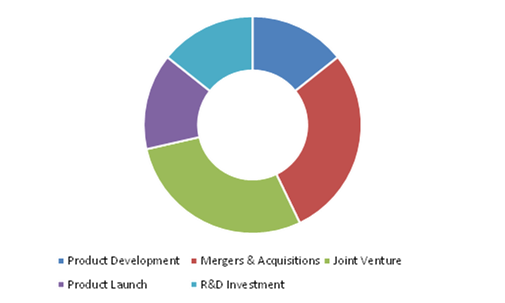Chatbot Market Report
RA05985
Chatbot Market, by Component Type (Solution, Services), Deployment (On-premise, Cloud), Usage (Website, Contact Centers, Social Media, Mobile Platform), End-User (Retail & E-commerce, BFSI, Healthcare, Travel & Tourism, Others), Regional Analysis (North America, Europe, Asia Pacific, LAMEA): Global Opportunity Analysis and Industry Forecast, 2020–2027
The global chatbot market forecast shall be $19,570 million by 2027, increasing from $2,568.3 million in 2019 at a healthy rate of 28.7%. Asia Pacific chatbot market is estimated to grow at a CAGR of 29.3% by registering a revenue of $5,049.1 million, throughout the analysis period. Massive expansion of information and communications technology infrastructure, combined with rising adoption of smartphone users particularly in India, China, and Australia are some of the factors driving the Asia-Pacific chatbot market during the forecast period.
Global Chatbot Market Analysis:
Chatbot is a computer application that is powered by artificial intelligence and it chats virtually to humans to solve queries or related problems in multiple languages. Furthermore, chatbots help in reducing the operational expense and increase overall efficiency.
Impact Analysis of COVID-19 on the Chatbot Market
The global chatbot market is expected to witness an upsurge in growth rate during the outbreak of COVID-19 pandemic, mainly because its deployment by various industrries such as banking & insurance, healthcare, and retail for responding to queries of customers and other tasks. Due to lockdown conditions in the majority of countries, remote work facility has been adopted by various organizations. The companies are highly dependent on chatbots to control the burden of customer queries due to less availability of employees.
However, certain companies operating in the chatbot market such as Google and IBM are coming forward with their strategic steps to help society, during the COVID-19 chaotic situation. For instance, in June 2020, The Andhra Pradesh National Health Mission announced that they have integrated with IBM Watson, a virtual agent, in order to help the people rapidly get answers to their queries regarding COVID-19. The innovative chatbot is developed to understand and respond to frequent questions about the pandemic in Telugu, Hindi, and English. Moreover, in April 2020, WHO (World Health Organization) announced that they have successfully launched Facebook messenger, their own version of WHO health alert platform to offer accurate and instant information about COVID-19. These key factors may generate investment opportunities for the chatbot industry, in the global marketplace.
Rising adoption of advanced chatbots by market leaders may flourish the global market for chatbot technologies
The chatbot industry is witnessing massive growth mainly because of the increase in the adoption of chatbots to handle queries and support customers. According to Salesforce.com, inc, an American cloud-based software company, more than 69% consumers prefer to use chatbots for speeding up communication.
Furthermore, strategic collaboration, product innovation, and business expansions of tech-giants are also expected to bolster the chatbot market, across the globe. For instance, in November, 2020, Microsoft entered into a collaboration with Novo Nordisk, a significant healthcare company specializing in diabetes care worldwide, in order to develop an AI Chinese-speaking chatbot for diabetic patients. Also, in April 2020, Amazon Web Services, Inc., commercialized AWS Chatbot for all customers. AWS Chatbot is an interactive agent that can receive crucial alerts, run commands to return diagnostic information, perform AWS Lambda functions, and develop AWS support cases. Such key developments may lead to an increase in the demand for chatbot services in the global market.
To know more about chatbot market drivers, get in touch with our analysts here.
Lack of awareness may restrain the growth of the global chatbot industry
Lack of awareness and other challenges such as complex management of chatbots may obstruct the market growth, which will ultimately hamper the global chatbot market, throughout the forecast period. Moreover, limited awareness about benefits of AI chatbots may limit the growth of adoption of chatbot in the global market.
The enormously growing adoption of self-learning chatbots to deliver more humanlike conversational experience may create huge opportunities for the global chatbot market in the future
In recent years, companies have been working on the development of self-learning chatbots. Hence, they are implementing various integrated technologies like cloud-based deployment, interference engine, natural language processor (NLP), and application programing interface (API). These self-learning chatbots can adapt easily with changing environment and conditions as they can learn from their previous conversations, actions, decisions and experience. Moreover, companies are collaborating with each other to serve integrated self-service technology to the customer. For instance, in February 2020, Creative Virtual announced partnership with Spitch AG to develop speech recognition as well as conversational AI together, particularly in the omnichannel solutions. The collaboration provides a multi-lingual voicebot to enhance sales and customer experience. Above-stated factors are expected to create positive opportunities for the global chatbot market, in the coming years.
To know more about Chatbot Market Opportunities, get in touch with our analysts here.
Chatbot Market, by Component Type:
Services segment for chatbot market expected generate a revenue of $8,825.8 million by 2027 at notable CAGR of 33.8%
Source: Research Dive Analysis
Service segment for chatbot market shall have the fastest growth and it is expected to generate a revenue of $8,825.8 million by 2027, growing from $843.6 million in 2019. The growth of this segment for the global chatbot market is mainly attributed to its features including powerful NLP, highly advanced multilingual capabilities, capability of real-time analysis, and cost-effectiveness. In addition to this, certain market leaders are emphasizing on the technological innovations to fulfil the needs of organizations. For instance, in March 2020, Maintel, the UK based cloud and managed services company, with a focus on communication has made an announcement that they have released the AI-powered Chatbot as service solutions in order to meet the increasing requirements of customers to digitally transform the experience.
Moreover, solution segment for chatbot market shall have a dominating share in the global market and is projected to register a revenue of $10,763.8 million, during the analysis timeframe owing to the technological advancements along with growing customer demand for self-services. These are some of the key factors are surging the demand for chatbots, in the global market, over the forecast period.
Chatbot Market, by Deployment:
The cloud deployment for chatbot market will have the fastest market growth due to exponentially rising popularity of intelligent bots such as Alexa among the customers
Source: Research Dive Analysis
The cloud sub-segment of the chatbot market will have the fastest growth and it is expected to surpass $11,298.0 million by 2027, with an increase from $1,144.5 million in 2019. Cloud-based chatbots handle multiple types of confidential business information including client contact details, employees’ social security numbers, invoices and accounting, supply chain management, and other business intelligence. Also, growing popularity of cloud-based natural-language intelligent bots, such as google assistant, Alexa, and Siri is also fueling the segment growth, over the forecast period.
On the other hand, the on premise sub-segment for the chatbot market will be a rapidly-growing segment and is estimated to generate a revenue of $8,297.2 million, throughout the analysis timeframe. Absolute control, excellent data security, and high flexibility are some of the reasons, businesses across the globe go for the adoption of on-premise chatbots platform. In addition, these platforms help in reducing dependency on vendors by giving sufficient room for customization along monitoring data access and usage more closely.
Chatbot Market, by Usage:
Social media for chatbot market will have the fastest market growth, during the forecast period
Source: Research Dive Analysis
The social media sub-segment for the chatbot market shall have rapid growth and is expected to generate a revenue of $4,686.4 million by 2027, throughout the review period. Chatbots help in increasing efficiency of work on social media mainly because it generates a more personal engagement with customers. Furthermore, discovering customer’s exact wants, shortening of sales cycle, and expansion of sales pipeline are some of the key factors responsible for the increased adoption of chatbots in the social media services.
The website segment for the chatbot market will have significant growth and it is projected to register a revenue of $5,848.8 million by 2027, during the analysis period. Integration of chatbot platform into website helps users in multiple ways such as ordering food, scheduling flights, and others. Hence, the adoption of chatbots in the website segment has seen dramatic growth, in the forecast period.
Chatbot Market, by End-User:
The travel and tourism segment for chatbot market will have lucrative growth due to growing demand for great tourism experiences
Source: Research Dive Analysis
Travel & tourism end-user for the global chatbot market will have magnificent growth and is further predicted to register a revenue of $2,591.1 million by 2027, during the forecast period. Extensively increasing demand for more meaningful travel experiences among the travelers across the globe can be one of the major factors driving the global chatbots market, during the forecast period. Chatbots come with multiple key benefits such as it is easy to access, informs users potential to customer regarding destinations & events, delivers more valuable information to clients, and increases the engagement rate. Hence, leading travel companies Kayak, Expedia are experimenting with chatbots, powered by a combination of NLP, live operators and machine learning, to serve customer service, sales support, and other commerce-related functions.
Regional Insights:
North America region has a significant market and it will reach up to $5,581.4 million by the end of 2027 owing to the strong presence of key players and their heavy investments into research & innovations
Source: Research Dive Analysis
The North America chatbot market accounted for $776.1 million in 2019 and is expected to register a revenue of $5,581.4 million by 2027. The market growth in the region is mainly driven by the enormous growth in the deployment of chatbots in multiple business verticals. In addition to this, technological innovations such as IoT, APIs, and artificial intelligence are evolving at a fast speed. Advanced chatbots are integrated with these technologies to provide enhanced operations, thereby boosting market demand.
Asia-Pacific chatbot market share is projected to grow at a CAGR of 29.3% by registering a revenue of $5,049.1 million by 2027. The Asia-Pacific region for chatbot market shows significant growth, as the region holds more than 50% of the global population, and hence any key technological shifts, such as AI and IoT are likely propel the market growth in the region. Massive expansion of information and communications technology infrastructures in the emerging countries, like India and China are projected to drive the market, during the forecast period. For example, in April 2020, Yellow Messenger, world’s fastest growing virtual assistant company, has announced that they have raised $20 million from an investor to cater the surging market’s demand.
Competitive Scenario in the Global Chatbot Market:
The advanced product development coupled with mergers & acquisitions are the frequent strategies followed by the significant market players
Source: Research Dive Analysis
Some of the leading chatbot market players include Kevit, Conversica, Inc, Yellow Messenger, CONTUS., KeyReply, Aivo, [24]7. ai, International Business Machine Corporation, Amazon Web Services, Inc, and Google Inc. Chatbot market players are focusing on novel product development, business expansion, and merger & acquisition. These are the effective strategies followed by the startup as well as established organizations.
Porter’s Five Forces Analysis for Chatbot Market:
- Bargaining Power of Suppliers: The chatbot technology players are high in number, and established companies of the chatbots are much larger and globalized. Hence, there will be less threat from the supplier. Thus, the bargaining power of the supplier is Moderate
- Bargaining Power of Buyer: Buyers shall have great bargaining power, mainly because of large number of players operating in the chatbot market. The chatbot service provider offers multiple features at an affordable price. The buyers can freely select products and services that best fit their preferences. Thus, the bargaining power of the buyer is HIGH
- Threat of New Entrants: The companies entering into the chatbot market are opting technological advancements to attract the users. Also, these companies are implementing multiple effective strategies to survive in the market. Thus, the bargaining power of the new entrant is Moderate
- Threat of Substitutes: There is no alternative product or service for chatbot so far. Thus, the threat of substitute is Low
- Competitive Rivalry in the Market: The competitive rivalry in the chatbot industry leaders is rather intense, especially between the global players including Microsoft, IBM, and Amazon. These tech giants are launching their value-added products and services in the global market and strengthening the footprint, across the world.Competitive rivalry in the market is High
| Aspect | Particulars |
| Historical Market Estimations | 2018-2019 |
| Base Year for Market Estimation | 2019 |
| Forecast timeline for Market Projection | 2020-2027 |
| Geographical Scope | North America, Europe, Asia-Pacific, LAMEA |
| Segmentation by Component |
|
| Segmentation by Deployment |
|
| Segmentation by Usage |
|
| Segmentation by End-User |
|
| Key Countries | U.S., Canada, Mexico, UK, Germany, France, Spain, Italy, Rest of Europe, China, India, Japan, South Korea, Australia, Rest of Asia-Pacific, Latin America, Middle East, Africa |
| Key Companies Profiled |
|
Q1. What is the size of the chatbot market?
A. The global chatbot market size was over $2,568.3 million in 2019 and is projected to reach $19,570 million by 2027.
Q2. Which are the major companies in the chatbot market?
A. Kevit, Conversica, Inc, and Yellow Messenger are some of the key players in the global chatbot Market.
Q3. Which region possesses greater investment opportunities in the coming future?
A. The Asia-Pacific region possesses great investment opportunities for the investors to witness the most promising growth in the future.
Q4. What is the growth rate of the Asia-Pacific market?
A. Asia-Pacific chatbot market is anticipated to grow at 29.3% CAGR during the forecast period.
Q5. What are the strategies opted by the leading players in this market?
A. Capacity expansion, product development, along with joint ventures are the key strategies opted by the operating companies in this market.
Q6. Which companies are investing more on R&D practices?
A. CONTUS., KeyReply, Aivo, and [24]7. ai companies are investing more on R&D activities for developing new products and technologies.
1. Research Methodology
1.1. Desk Research
1.2. Real time insights and validation
1.3. Forecast model
1.4. Assumptions and forecast parameters
1.4.1. Assumptions
1.4.2. Forecast parameters
1.5. Data sources
1.5.1. Primary
1.5.2. Secondary
2. Executive Summary
2.1. 360° summary
2.2. By Component type trends
2.3. By deployment trends
2.4. By Usage trends
2.5. By End-User trends
3. Market overview
3.1. Market segmentation & definitions
3.2. Key takeaways
3.2.1. Top investment pockets
3.2.2. Top winning strategies
3.3. Porter’s five forces analysis
3.3.1. Bargaining power of consumers
3.3.2. Bargaining power of suppliers
3.3.3. Threat of new entrants
3.3.4. Threat of substitutes
3.3.5. Competitive rivalry in the market
3.4. Market dynamics
3.4.1. Drivers
3.4.2. Restraints
3.4.3. Opportunities
3.5. Technology landscape
3.6. Regulatory landscape
3.7. Patent landscape
3.8. Pricing overview
3.8.1. by Component Type
3.8.2. by Deployment type
3.8.3. by Usage type
3.8.4. by End-User type
3.9. Market value chain analysis
3.9.1. Stress point analysis
3.9.2. Raw material analysis
3.9.3. Manufacturing process
3.9.4. Distribution channel analysis
3.9.5. Operating vendors
3.9.5.1. Raw material suppliers
3.9.5.2. Product manufacturers
3.9.5.3. Product distributors
3.10. Strategic overview
4. Chatbot Market, by Component Type
4.1. Solution
4.1.1. Market size and forecast, by region, 2019-2027
4.1.2. Comparative market share analysis, 2019 & 2027
4.2. Services
4.2.1. Market size and forecast, by region, 2019-2027
4.2.2. Comparative market share analysis, 2019 & 2027
5. Chatbot Market, by Deployment
5.1. Cloud
5.1.1. Market size and forecast, by region, 2019-2027
5.1.2. Comparative market share analysis, 2019 & 2027
5.2. On-premise
5.2.1. Market size and forecast, by region, 2019-2027
5.2.2. Comparative market share analysis, 2019 & 2027
6. Chatbot Market, by Usage
6.1. Website
6.1.1. Market size and forecast, by region, 2019-2027
6.1.2. Comparative market share analysis, 2019 & 2027
6.2. Contact Centers
6.2.1. Market size and forecast, by region, 2019-2027
6.2.2. Comparative market share analysis, 2019 & 2027
6.3. Social Media
6.3.1. Market size and forecast, by region, 2019-2027
6.3.2. Comparative market share analysis, 2019 & 2027
6.4. Mobile Platform
6.4.1. Market size and forecast, by region, 2019-2027
6.4.2. Comparative market share analysis, 2019 & 2027
7. Chatbot Market, End-User
7.1. Retail & E-commerce
7.1.1. Market size and forecast, by region, 2019-2027
7.1.2. Comparative market share analysis, 2019 & 2027
7.2. BFSI
7.2.1. Market size and forecast, by region, 2019-2027
7.2.2. Comparative market share analysis, 2019 & 2027
7.3. Healthcare
7.3.1. Market size and forecast, by region, 2019-2027
7.3.2. Comparative market share analysis, 2019 & 2027
7.4. Travel & Tourism
7.4.1. Market size and forecast, by region, 2019-2027
7.4.2. Comparative market share analysis, 2019 & 2027
7.5. Others
7.5.1. Market size and forecast, by region, 2019-2027
7.5.2. Comparative market share analysis, 2019 & 2027
8. Chatbot Market, by Region
8.1. North America
8.1.1. Market size and forecast, by component type, 2019-2027
8.1.2. Market size and forecast, by deployment, 2019-2027
8.1.3. Market size and forecast, by usage, 2019-2027
8.1.4. Market size and forecast, by end-user, 2019-2027
8.1.5. Market size and forecast, by country, 2019-2027
8.1.6. Comparative market share analysis, 2019 & 2027
8.1.7. U.S.
8.1.7.1. Market size and forecast, by component type, 2019-2027
8.1.7.2. Market size and forecast, by deployment, 2019-2027
8.1.7.3. Market size and forecast, by usage, 2019-2027
8.1.7.4. Market size and forecast, by end-user, 2019-2027
8.1.7.5. Comparative market share analysis, 2019 & 2027
8.1.8. Canada
8.1.8.1. Market size and forecast, by component type, 2019-2027
8.1.8.2. Market size and forecast, by deployment, 2019-2027
8.1.8.3. Market size and forecast, by usage, 2019-2027
8.1.8.4. Market size and forecast, by end-user, 2019-2027
8.1.8.5. Comparative market share analysis, 2019 & 2027
8.1.9. Mexico
8.1.9.1. Market size and forecast, by component type, 2019-2027
8.1.9.2. Market size and forecast, by deployment, 2019-2027
8.1.9.3. Market size and forecast, by usage, 2019-2027
8.1.9.4. Market size and forecast, by end-user, 2019-2027
8.1.9.5. Comparative market share analysis, 2019 & 2027
8.2. Europe
8.2.1. Market size and forecast, by component type, 2019-2027
8.2.2. Market size and forecast, by deployment, 2019-2027
8.2.3. Market size and forecast, by usage, 2019-2027
8.2.4. Market size and forecast, by end-user, 2019-2027
8.2.5. Market size and forecast, by country, 2019-2027
8.2.6. Comparative market share analysis, 2019 & 2027
8.2.7. Germany
8.2.7.1. Market size and forecast, by component type, 2019-2027
8.2.7.2. Market size and forecast, by deployment, 2019-2027
8.2.7.3. Market size and forecast, by usage, 2019-2027
8.2.7.4. Market size and forecast, by end-user, 2019-2027
8.2.7.5. Comparative market share analysis, 2019 & 2027
8.2.8. UK
8.2.8.1. Market size and forecast, by component type, 2019-2027
8.2.8.2. Market size and forecast, by deployment, 2019-2027
8.2.8.3. Market size and forecast, by usage, 2019-2027
8.2.8.4. Market size and forecast, by end-user, 2019-2027
8.2.8.5. Comparative market share analysis, 2019 & 2027
8.2.9. France
8.2.9.1. Market size and forecast, by component type, 2019-2027
8.2.9.2. Market size and forecast, by deployment, 2019-2027
8.2.9.3. Market size and forecast, by usage, 2019-2027
8.2.9.4. Market size and forecast, by end-user, 2019-2027
8.2.9.5. Comparative market share analysis, 2019 & 2027
8.2.10. Spain
8.2.10.1. Market size and forecast, by component type, 2019-2027
8.2.10.2. Market size and forecast, by deployment, 2019-2027
8.2.10.3. Market size and forecast, by usage, 2019-2027
8.2.10.4. Market size and forecast, by end-user, 2019-2027
8.2.10.5. Comparative market share analysis, 2019 & 2027
8.2.11. Italy
8.2.11.1. Market size and forecast, by component type, 2019-2027
8.2.11.2. Market size and forecast, by deployment, 2019-2027
8.2.11.3. Market size and forecast, by usage, 2019-2027
8.2.11.4. Market size and forecast, by end-user, 2019-2027
8.2.11.5. Comparative market share analysis, 2019 & 2027
8.2.12. Rest of Europe
8.2.12.1. Market size and forecast, by component type, 2019-2027
8.2.12.2. Market size and forecast, by deployment, 2019-2027
8.2.12.3. Market size and forecast, by usage, 2019-2027
8.2.12.4. Market size and forecast, by end-user, 2019-2027
8.2.12.5. Comparative market share analysis, 2019 & 2027
8.3. Asia Pacific
8.3.1. Market size and forecast, by component type, 2019-2027
8.3.2. Market size and forecast, by deployment, 2019-2027
8.3.3. Market size and forecast, by usage, 2019-2027
8.3.4. Market size and forecast, by end-user, 2019-2027
8.3.5. Market size and forecast, by country, 2019-2027
8.3.6. Comparative market share analysis, 2019 & 2027
8.3.7. China
8.3.7.1. Market size and forecast, by component type, 2019-2027
8.3.7.2. Market size and forecast, by deployment, 2019-2027
8.3.7.3. Market size and forecast, by usage, 2019-2027
8.3.7.4. Market size and forecast, by end-user, 2019-2027
8.3.7.5. Comparative market share analysis, 2019 & 2027
8.3.8. India
8.3.8.1. Market size and forecast, by component type, 2019-2027
8.3.8.2. Market size and forecast, by deployment, 2019-2027
8.3.8.3. Market size and forecast, by usage, 2019-2027
8.3.8.4. Market size and forecast, by end-user, 2019-2027
8.3.8.5. Comparative market share analysis, 2019 & 2027
8.3.9. Australia
8.3.9.1. Market size and forecast, by component type, 2019-2027
8.3.9.2. Market size and forecast, by deployment, 2019-2027
8.3.9.3. Market size and forecast, by usage, 2019-2027
8.3.9.4. Market size and forecast, by end-user, 2019-2027
8.3.9.5. Comparative market share analysis, 2019 & 2027
8.3.10. Rest of Asia Pacific
8.3.10.1. Market size and forecast, by component type, 2019-2027
8.3.10.2. Market size and forecast, by deployment, 2019-2027
8.3.10.3. Market size and forecast, by usage, 2019-2027
8.3.10.4. Market size and forecast, by end-user, 2019-2027
8.3.10.5. Comparative market share analysis, 2019 & 2027
8.4. LAMEA
8.4.1. Market size and forecast, by component type, 2019-2027
8.4.2. Market size and forecast, by deployment, 2019-2027
8.4.3. Market size and forecast, by usage, 2019-2027
8.4.4. Market size and forecast, by end-user, 2019-2027
8.4.5. Market size and forecast, by country, 2019-2027
8.4.6. Comparative market share analysis, 2019 & 2027
8.4.7. Latin America
8.4.7.1. Market size and forecast, by component type, 2019-2027
8.4.7.2. Market size and forecast, by deployment, 2019-2027
8.4.7.3. Market size and forecast, by usage, 2019-2027
8.4.7.4. Market size and forecast, by end-user, 2019-2027
8.4.7.5. Comparative market share analysis, 2019 & 2027
8.4.8. Middle East
8.4.8.1. Market size and forecast, by component type, 2019-2027
8.4.8.2. Market size and forecast, by deployment, 2019-2027
8.4.8.3. Market size and forecast, by usage, 2019-2027
8.4.8.4. Market size and forecast, by end-user, 2019-2027
8.4.8.5. Comparative market share analysis, 2019 & 2027
8.4.9. Africa
8.4.9.1. Market size and forecast, by component type, 2019-2027
8.4.9.2. Market size and forecast, by deployment, 2019-2027
8.4.9.3. Market size and forecast, by usage, 2019-2027
8.4.9.4. Market size and forecast, by end-user, 2019-2027
8.4.9.5. Comparative market share analysis, 2019 & 2027
9. Company profiles
9.1. Google Inc.
9.1.1. Business overview
9.1.2. Financial performance
9.1.3. Product portfolio
9.1.4. Recent strategic moves & developments
9.1.5. SWOT analysis
9.2. Amazon Web Services, Inc.
9.2.1. Business overview
9.2.2. Financial performance
9.2.3. Product portfolio
9.2.4. Recent strategic moves & developments
9.2.5. SWOT analysis
9.3. INTERNATIONAL BUSINESS MACHINES CORPORATION
9.3.1. Business overview
9.3.2. Financial performance
9.3.3. Product portfolio
9.3.4. Recent strategic moves & developments
9.3.5. SWOT analysis
9.4. [24]7. Ai, Inc.
9.4.1. Business overview
9.4.2. Financial performance
9.4.3. Product portfolio
9.4.4. Recent strategic moves & developments
9.4.5. SWOT analysis
9.5. Aivo
9.5.1. Business overview
9.5.2. Financial performance
9.5.3. Product portfolio
9.5.4. Recent strategic moves & developments
9.5.5. SWOT analysis
9.6. KeyReply.
9.6.1. Business overview
9.6.2. Financial performance
9.6.3. Product portfolio
9.6.4. Recent strategic moves & developments
9.6.5. SWOT analysis
9.7. CONTUS
9.7.1. Business overview
9.7.2. Financial performance
9.7.3. Product portfolio
9.7.4. Recent strategic moves & developments
9.7.5. SWOT analysis
9.8. Yellow Messenger
9.8.1. Business overview
9.8.2. Financial performance
9.8.3. Product portfolio
9.8.4. Recent strategic moves & developments
9.8.5. SWOT analysis
9.9. Conversica, Inc.
9.9.1. Business overview
9.9.2. Financial performance
9.9.3. Product portfolio
9.9.4. Recent strategic moves & developments
9.9.5. SWOT analysis
9.10. Kevit
9.10.1. Business overview
9.10.2. Financial performance
9.10.3. Product portfolio
9.10.4. Recent strategic moves & developments
9.10.5. SWOT analysis
Chatbot is a software of artificial intelligence (AI) used to conduct or simulate a chat conversation via text-to-speech or text. This software helps business teams to converse with a user or potential customer in natural language through websites, mobile apps, messaging applications, and through the telephone. Chatbots are implemented across the banking, financial services, and insurance (BFSI) sector to interact with customers and provide better user experience.
Impact of COVID-19 on the Industry
The global chatbot market is anticipated to observe fueling growth during the COVID-19 pandemic. This is majorly owing to the increasing deployment of chatbots by multiple industries such as healthcare, banking & insurance, and retail for customer support and responding to queries. In addition, various organizations across the globe have allowed their employees to work remotely, and are thus highly dependent on chatbots to control the customer’s burden. This is also another factor expected to help the global market to witness an acceleration in growth in the COVID-19 chaos.
However, many companies functioning in the chatbot market are taking strategic steps to help people during the pandemic. For instance, in April 2020, the World Health Organization (WHO) announced to have successfully launched their own version of health platform on Facebook messenger, to offer instant and accurate information related to COVID-19. This is predicted to create lucrative opportunities for the market growth in the coming years.
Key Developments in the Industry
The key companies operating in the industry are adopting various growth strategies & business tactics such as partnerships, collaborations, mergers & acquisitions, and launches to maintain a robust position in the overall market, which is subsequently helping the chatbot market to grow exponentially.
For instance, in January 2019, Ingenico Group announced the launch of its innovative payment-enabled chatbot that uses natural language processing (NLP) from IBM Watson to create a better & smooth customer experience by understanding & interpreting users in various languages & phrasing. Earlier, IBM and Ingenico entered into a partnership to build this payment-enabled chatbot with an aim to deliver personalized experience to its customers.
In April 2019, Google and Salesforce entered into a strategic partnership to develop smart customer experience. The aim of both the companies behind this partnership is to integrate Dialogflow Enterprise Edition of Google along with Salesforce’s Einstein platform product offerings for customer support & services. The focus of the companies is at developing a solution, (a chatbot) to create an improved customer service experience.
Forecast Analysis of Global Chatbot Market
The global chatbot market is anticipated to observe a noteworthy growth over the forecast period, due to growing adoption of various technologies such as interference engine, application programing interface (API), cloud-based deployment, and natural language processor (NLP). Conversely, the lack of awareness regarding the benefits of AI chatbots is estimated to hamper the global market growth in the near future.
The growing adoption of advanced chatbots by various industry verticals such as BFSI, retail, healthcare, and others to handle queries or support for customers is the significant factor anticipated to bolster the growth of the global chatbot market during the forecast period. As per a newly published report by Research Dive, the chatbot market is expected to garner $19,570.0 million by 2027. Geographically, the North America market for chatbot is estimated to dominate the global industry, owing to enormous growth in deployment of chatbots in various business verticals in the region. The key players operating in the global industry include Conversica, Inc., Kevit,, Yellow Messenger, KeyReply, CONTUS., Aivo, [24]7.ai, Amazon Web Services, Inc., International Business Machine Corporation, and Google Inc.
Personalize this research
- Triangulate with your own data
- Request your format and definition
- Get a deeper dive on a specific application, geography, customer or competitor
- + 1-888-961-4454 Toll - Free
- support@researchdive.com

